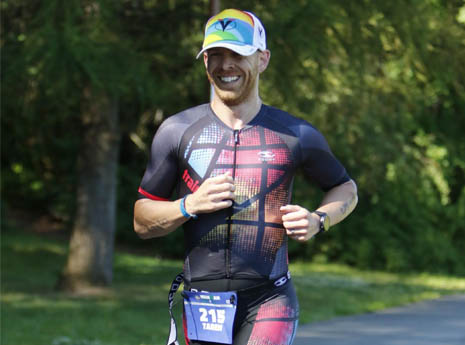One of the biggest misconceptions about triathlon training is that to race faster, you need to train faster. Unfortunately, that's really not the case. Instead, this can actually lead to burnout, sickness, injury and race times that don't seem to budge year after year. To become faster, don't focus on making your fast efforts faster, but rather making your easy efforts faster. Doing so will allow you to race faster while maintaining a lower heart rate, which will make a faster pace seem easier.
Train to Make Your Easy Running Faster
Step 1: Calculate the heart rate ceiling you'll use for your low heart rate training. The quickest way to do this is to use the formula of 180 minus your age. So if you're 36, then 180-36=144 heart rate ceiling for heart rate training. If you want a more precise number to shoot for, try this method instead.
Step 2: Over the course of a training year, accumulate 70 to 80 percent of your total training time within zero to 10 beats per minute under the heart rate ceiling you calculated in Step 1.
This type of low heart rate training builds a huge amount of cardiovascular fitness; it burns a ton of fat during the exercise, it creates mitochondrial density so your muscles can use oxygen more efficiently and it's easy enough that when you perform a fast workout, you'll be fresh and can go much faster.
The Devil Is in the Details
When triathletes start heart rate training, a number of questions always come up.
Q: What if I need to take walk breaks to keep my heart rate under the ceiling?
A: Then take walk breaks!
Q: Is the heart rate ceiling the same for biking and running?
A: Yes. It'll be easier to keep your heart rate under the ceiling on the bike than on the run. That's OK because running is hard on the body. Be cautious and make sure your running is done at a low intensity.
Q: How do I deal with heart rate training in the pool?
A: The hydrostatic pressure of the water around your body will naturally keep your heart rate low, so consider almost all swimming to be in the 80 percent, low heart rate training time.
Q: Do I have to accumulate 80 percent of my time in low heart rates every workout and every week?
A: No, the 70 to 80 percent of total training time done at low heart rates is accumulated over the course of a year. The offseason and base-building seasons will be almost entirely low heart rate while race season will be much more intense and likely closer to 60 percent at low heart rates. Long rides, long runs and swims will be mostly low heart rate while interval bikes and runs will be almost entirely high heart rate.
Q: How soon will I see results?
A: Results won't be instant, but in several months you'll notice your paces per mile will get faster at the same heart rate, or you'll be able to push higher power at the same heart rate. At this point, you've absorbed the low heart rate training, and your faster paces will seem easier.
READ THIS NEXT: 8 Questions Triathletes Are Really Tired of Hearing


